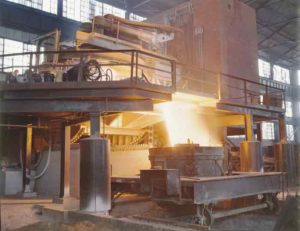VAD is the abbreviation of vacuum arc degassing, VAD method is co-developed by Finkl company and Mohr company, so it is also called Finkl-Mohr method or Finkl-VAD method. VAD furnace are mainly used to process carbon steel, tool steel, bearing steel, high ductility steel and so on.
VAD refining equipment is mainly composed of steel ladle, vacuum system, electric arc heating equipment and ferroalloy adding equipment.

VAD method characteristics
- Good degassing effect during heating, because electric arc heating is done at vacuum condition.
- Can accurately adjust steel liquid casting temperature, steel ladle inner lining can adequately regenerate heat, temperature drop is stable during casting.
- Steel liquid can be fully stirred during refining, steel liquid composition is stable.
- Large amount of alloy can be added into steel liquid, smelting species range is wide.
- Slagging agents and other slagging materials can be added for desulfurization, decarburization. If oxygen gun is equipped at vacuum cover, vacuum oxygen decarburization method can be used for smelting ultra low carbon stainless steel.
The function of VAD furnace steel ladle is equivalent to electric arc smelting furnace. VAD furnace works at vacuum condition, steel ladle working lining suffers steel liquid and molten slag chemical corrosion and mechanical washing, meanwhile, electric arc thermal radiation is strong, temperature is high, hot spot zone will have severer damage. With the addition of slagging agent, slag corrosion is severe, especially slag line zone and upper part, corrosion rate is even faster.
The selection of VAD ladle lining refractory materials should adopt different kinds of refractory bricks according to actual craft condition, so the service life is prolonged and refractory materials consumption is reduced.
Refractory materials used in VAD method mainly include: magnesia chrome bricks, magnesia carbon bricks, dolomite bricks and so on.
Working lining mainly adopts direct bonded magnesia chrome bricks, rebonded magnesite chrome bricks and semi rebonded magnesia chromite bricks, magnesite carbon bricks ,fired or unfired high alumina bricks and low temperature treated dolomite bricks, etc. Permanent lining usually adopts generally application magnesia chrome bricks, fireclay bricks and lightweight high alumina bricks.
In some VAD furnaces, ladle bottom working lining usually adopts zircon bricks and zircon refractory ramming mixes. Below slag line part is lined by high alumina bricks. Slag line part is constructed by direct bonded magnesia chrome bricks. Above slag line hot spot is built by direct bonded magnesia carbon bricks, while the rest part is brick worked by direct bonded magnesite chromite bricks.
VAD ladles slag line part also adopts direct bonded magnesia chrome bricks and fused magnesia chrome bricks. Ladle bottom working lining is lined by zircon bricks. Porous plug is high alumina mullite based, and the rest parts are all built by unfired high alumina bricks.
Post time: Feb-15-2022
